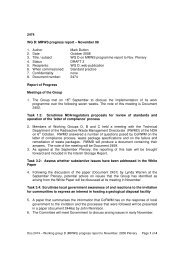2009 Report to Government on National Research and
2009 Report to Government on National Research and
2009 Report to Government on National Research and
- TAGS
- corwm.decc.gov.uk
Create successful ePaper yourself
Turn your PDF publications into a flip-book with our unique Google optimized e-Paper software.
3.62 BGS is c<strong>on</strong>ducting three projects relevant <str<strong>on</strong>g>to</str<strong>on</strong>g> geological disposal within its NERC<br />
Science Programme remit. These are: Bio-Tran, investigating microbial transport<br />
<strong>and</strong> microbial indica<str<strong>on</strong>g>to</str<strong>on</strong>g>rs of mass transport through geological media; Geosphere<br />
C<strong>on</strong>tainment, developing fundamental underst<strong>and</strong>ing of the mass transport<br />
properties <strong>and</strong> hydromechanical behaviour of low permeability media<br />
(anthropogenic <strong>and</strong> natural) with applicati<strong>on</strong> <str<strong>on</strong>g>to</str<strong>on</strong>g> radioactive waste disposal,<br />
carb<strong>on</strong> dioxide sequestrati<strong>on</strong>, gas s<str<strong>on</strong>g>to</str<strong>on</strong>g>rage <strong>and</strong> c<strong>on</strong>taminant transport; <strong>and</strong><br />
Paleohydrogeology, developing paleohydrogeology techniques <str<strong>on</strong>g>to</str<strong>on</strong>g> support<br />
geological disposal. Direct support from NERC for these programmes was about<br />
£470K over a seven-year period from 2003-2010.<br />
3.63 BGS is involved in, <strong>and</strong> in some instances leads, research programmes directed<br />
at underst<strong>and</strong>ing the behaviour of the engineered comp<strong>on</strong>ents of a GDF in the<br />
sub-surface <strong>and</strong> characterising host rock masses <strong>and</strong> their fracture systems. The<br />
areas include projects <strong>on</strong> ben<str<strong>on</strong>g>to</str<strong>on</strong>g>nite, the engineering disturbed z<strong>on</strong>e (EDZ)<br />
fracture transmissivity <strong>and</strong> near-field chemical c<strong>on</strong>tainment. A series of<br />
geological disposal-related research studies have been carried out by BGS for<br />
Japanese c<strong>on</strong>trac<str<strong>on</strong>g>to</str<strong>on</strong>g>rs. These focused <strong>on</strong> the characterisati<strong>on</strong> of fluid pathways<br />
<strong>and</strong> fluid-rock interacti<strong>on</strong>s in the Mizunami URL site, H<strong>on</strong>shu, Japan.<br />
3.64 NERC also has the ability <str<strong>on</strong>g>to</str<strong>on</strong>g> fund research through CEH, which is a NERCfunded<br />
institute for integrated research in terrestrial <strong>and</strong> freshwater ecosystems<br />
<strong>and</strong> their interacti<strong>on</strong> with the atmosphere. In recent years, no research of direct<br />
relevance <str<strong>on</strong>g>to</str<strong>on</strong>g> the management of higher activity wastes has been funded by<br />
NERC via the CEH.<br />
Other <strong>Research</strong> Councils<br />
3.65 BBSRC funds research relating <str<strong>on</strong>g>to</str<strong>on</strong>g> the underst<strong>and</strong>ing <strong>and</strong> exploitati<strong>on</strong> of<br />
biological systems. Its remit includes research at all levels of biological systems,<br />
from molecules <strong>and</strong> cells through tissues <str<strong>on</strong>g>to</str<strong>on</strong>g> whole populati<strong>on</strong>s <strong>and</strong> their<br />
interacti<strong>on</strong>s; it covers plants, animals <strong>and</strong> microbes. It also supports a number of<br />
important industrial stakeholders, including the agriculture, food, chemical,<br />
healthcare <strong>and</strong> pharmaceutical sec<str<strong>on</strong>g>to</str<strong>on</strong>g>rs. Its current budget is about £420M per<br />
annum. Its current strategic priorities include global security, living with<br />
envir<strong>on</strong>mental change <strong>and</strong> bi<strong>on</strong>anotechnology. BBSRC does not have any<br />
current grants in the area of radioactive waste management or remediati<strong>on</strong> of<br />
radioactively c<strong>on</strong>taminated l<strong>and</strong>. This c<strong>on</strong>trasts markedly with the USA<br />
programme, where biological effects <strong>on</strong> radioactive c<strong>on</strong>taminati<strong>on</strong>, <strong>and</strong><br />
bioremediati<strong>on</strong>, have been str<strong>on</strong>gly supported over many years, initially through<br />
the dedicated Natural <strong>and</strong> Accelerated Bioremediati<strong>on</strong> Program (NABIR) <strong>and</strong><br />
subsequently within the wider Envir<strong>on</strong>mental Remediati<strong>on</strong> Sciences Program<br />
(ERSP). 6 Similarly, the Swedish Deep Biosphere Labora<str<strong>on</strong>g>to</str<strong>on</strong>g>ry 7 has existed for<br />
over 20 years, c<strong>on</strong>ducting a biological research programme in support of<br />
geological disposal.<br />
3.66 ESRC is the UK’s leading agency for research funding <strong>and</strong> training in ec<strong>on</strong>omic<br />
<strong>and</strong> social sciences. It receives most of its funding (about £203M per annum)<br />
from BIS. It has recently reviewed its strategic plan which now includes a<br />
6 http://esd.lbl.gov/research/projects/ersp/generalinfo/intro.html<br />
7 http://www.gmm.gu.se/groups/pedersen/index.php<br />
CoRWM Document 2543, Oc<str<strong>on</strong>g>to</str<strong>on</strong>g>ber <str<strong>on</strong>g>2009</str<strong>on</strong>g> Page 41 of 151



